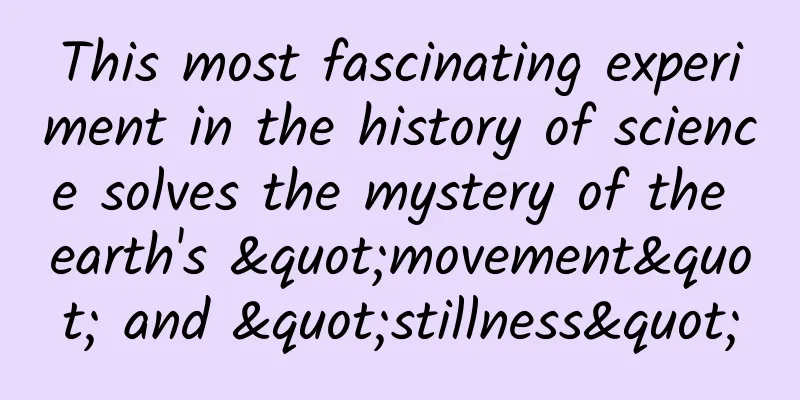This most fascinating experiment in the history of science solves the mystery of the earth's "movement" and "stillness"

|
© Trinity College Dublin Leviathan Press: Foucault's pendulum seems to be relatively simple, but in fact it requires great care when setting it up, because any uncertain structure may cause the pendulum to turn extra, which can be mistaken for the influence of the earth. The initial start of the pendulum is very important. The traditional operation method is to use a flame to burn the cotton thread that temporarily binds the plumb bob to avoid unnecessary lateral movement. In addition, air resistance will attenuate the oscillation, so the Foucault pendulum in museums today often combines electromagnetic or other drive devices to keep the plumb bob swinging. On March 31, 1851, a group of curious Parisians gathered at the Panthéon to watch a historic scientific demonstration. In the center of the building, beneath its soaring dome, they found a seemingly simple device: a 28-kilogram copper-coated lead ball suspended from the dome by a 67-meter-long cable. On the ground, a wooden platform was placed, covered with a thin layer of sand. The metal ball was fixed to the wall by a rope. The crowd gradually quieted down. The organizer of the demonstration, 32-year-old amateur scientist Léon Foucault, stepped forward and used a lit candle to burn the rope holding the metal ball, releasing the ball. As everyone watched, the pendulum swung slowly across the hall, and the cone at the bottom of the ball drew a line on the sand every time it passed. A replica of the Foucault pendulum experiment at the Museo Nazionale della Scienza e Tecnica in Milan, Italy. © Wikimedia Commons At first, nothing changed, but as time went on, something incredible happened. Gradually, the line in the sand began to move, running steadily clockwise around the platform. In less than an hour, it had rotated more than 10 degrees, and by the next day, it had made a full circle and returned to its original starting point. Using only the most basic equipment, Léon Foucault finally demonstrated what many had long suspected but had been unable to prove: that the Earth does rotate on its axis. This is one of the most elegant and powerful experimental stories in the history of science. © vitotechnology For most of human history, people believed that the Earth was at the center of the universe, and that the Sun, Moon, stars, and planets all revolved around it—the “geocentric” model of the universe. But in the 16th and 17th centuries, thanks to the efforts of scientists such as Copernicus, Kepler, and Galileo, humans gradually adopted the “heliocentric” model, in which the Earth and planets orbited the Sun. An important factor in this change in cosmic ideas was the problem of retrograde motion—a curious phenomenon in which planets sometimes experience a temporary “backward” movement before resuming their original motion. In the second century AD, the Roman astronomer Claudius Ptolemaeus reconciled retrograde motion with the geocentric model by proposing that the planets moved in epicycles. But while the Ptolemaic model worked well for practical purposes like predicting astronomical events or setting calendars, the concept of epicycles was clumsy and could not be explained by the known laws of motion. The geocentric model was much more elegant, easily explaining that retrograde motion was the result of the planets overtaking each other's orbits. It also fit in perfectly with the laws of gravity and motion discovered by Sir Isaac Newton a century later. However, while these theories and observations clearly demonstrated that the Earth orbited the Sun, they provided no information as to whether the Earth rotated on its own axis. Astronomers had long assumed that the Earth did rotate, due to the circular paths described by the Sun and stars in the sky, but no one had been able to provide any conclusive evidence of this fact. The first solid clue that the Earth does rotate came largely by accident. In 1573, English astronomer Thomas Digges predicted that if the Earth did orbit the Sun, the positions of the stars should change slightly over the course of the year, a phenomenon called stellar parallax. Over the next century, several astronomers, including Frenchman Jean Picard and Englishmen John Flamsteed and Robert Hooke, confirmed that this was indeed the case. Parallax motion of stars from annual parallax. © vitotechnology Unfortunately, the magnitude and annual cycle of this variation did not correspond to that due to parallax, and the discrepancy puzzled astronomers until 1728, when James Bradley, the third British Astronomer Royal, realized that the variation (which he called stellar aberration) was caused not by the Earth's revolution around the Sun but by its rotation. The simplest analogy for this phenomenon is walking in the rain. If you're standing still, with no wind or other similar factors, then the rain is simply falling from above. But when you walk or run, the raindrops hit you head-on; so even though the rain is falling straight down, from your frame of reference, your motion makes it appear to be falling at an angle. Similarly, the motion of the Earth through space makes light from distant stars (which travel in straight lines) appear to arrive with slight angular deviations, causing the apparent position of the light source to change. As early as 1687, Sir Isaac Newton proposed an empirical test of the Earth's rotation. In his seminal work Philosophiae Naturalis Principia Mathematica, Newton predicted that the centrifugal force generated by the Earth's rotation would cause the Earth to bulge around the equator. If this were true, then gravity would be slightly stronger at the equator than at the poles - a phenomenon that could be measured, for example, by timing the swing of a pendulum. In fact, French astronomer Jean Richer had already conducted such an experiment in 1673, and found that the second pendulum (a pendulum that completes one swing every two seconds) swung 2.8 millimeters less in French Guiana than in Paris. In 1736, the French sent two expeditions to measure one degree of arc of the meridian near the poles and the equator. They indeed found that the earth was flattened at the poles and bulged at the equator, which confirmed Newton's suspicion and further supported the view that the earth rotated on its axis. © Wikimedia Commons Another of Newton's conjectures was that a freely falling object would fall slightly to the east of its point of release - a phenomenon now known as the Coriolis Effect. This effect is responsible for the clockwise rotation of large weather systems such as hurricanes and cyclones in the Northern Hemisphere and counterclockwise rotation in the Southern Hemisphere, and it must be taken into account when firing artillery shells over long distances. However, contrary to popular belief, the Coriolis effect does not cause toilet flush water to rotate in different directions in different hemispheres. A hurricane can be hundreds of kilometers in diameter and last for many days, while a sink or toilet is relatively small, and the time it takes for the Coriolis effect to affect the amount of water discharged is very short. © Giphy In fact, when we talk about the direction of drains in sinks, toilets, and bathtubs, the Coriolis effect has a negligible effect, especially compared to other factors that affect water flow, such as the shape of the sink and the direction of the toilet spout. In this case, the Coriolis effect has about the same effect on the vortex in a toilet as the flapping of a butterfly's wings has on a tornado. In any case, based on Newton's prediction, in 1679, the English scientist Robert Hooke tried to measure the eastward deflection of an object dropped from a height of 8.2 meters. However, this distance was too short to obtain a measurement result. It was not until 100 years later that three scientists, Giovanni Guglielmini, Johan Benzenberg and Ferdinand Reich, confirmed the existence of the Coriolis effect by dropping objects from a 150-meter tower. Although these experiments were convincing enough to convince the scientific community, the results were too small and mysterious for the general public, who still had doubts about the Earth's rotation. This is where Leon Foucault and his famous pendulum came in. Jean Bernard Léon Foucault was born in Paris on September 18, 1819. His father was a publisher, but he died when Foucault was 9, and his mother was often ill, so he was educated mostly at home. As a child, he showed a remarkable talent for mechanics, being able to build devices such as telegraphs and steam engines. After completing his Bachelor of Arts, Foucault began to study medicine. However, he soon dropped out of school due to his fear of blood, and later became a laboratory assistant for bacteriologist Alfred Donné. Three years later, Foucault collaborated with physicist Hippolyte Fizeau to conduct various experiments on the nature and properties of light. He also became interested in Louis Daguerre's newly invented daguerreotype, and made several improvements to it. However, by 1850, Foucault and Fizeau had fallen out and parted ways. In 1851, the two conducted independent experiments and measured the speed of light to within 5% of the currently accepted value. Foucault also determined that light travels slower in water than in air, which helped to disprove Sir Isaac Newton's "corpuscle" or particle theory of light and moved the scientific establishment toward the wave theory of light - but that's another story for another time. Léon Foucault (1819-1868). © Astronoo One evening in early January 1851, Foucault had his most famous insight: that the Earth’s rotation could be demonstrated using a large pendulum. The Foucault pendulum worked on the same principle as the Coriolis effect: Like a flying cannonball or a falling weight, the swinging pendulum moves in a straight line or fixed plane, independent of the Earth’s rotation—in other words, in an inertial reference frame. As long as there are no external forces acting on it, the pendulum will continue to swing along this plane, which means that as the Earth rotates beneath it, this plane will rotate relative to its starting position - clockwise in the Northern Hemisphere and counterclockwise in the Southern Hemisphere. The speed of this rotation depends on the latitude at which the pendulum is located. At the poles, it rotates once every 24 hours, while at the equator, it does not rotate at all. At any other latitude, the rate of rotation is proportional to the sine of the latitude angle. For example, at 48.85 degrees north latitude in Paris, the Foucault pendulum rotates once every 31.85 hours. Since the pendulum's suspension point is fixed to the Earth, the plane of oscillation does not really remain fixed, but rotates at a rate of 180 degrees per day, returning to its original position every two days. To achieve the desired result, Foucault had to construct the pendulum very carefully. The anchor point of the suspension cable had to be a universal joint so that it would not swing in any direction, while the cable itself had to be as flexible, uniform, and free of defects as possible to prevent unwanted resonances. Because uneven air resistance would also deflect the pendulum, the pendulum ball had to be streamlined, symmetrical, and as massive as possible. Finally, any external force in the process of releasing the pendulum would severely affect the swing - this is why Foucault's pendulum is usually released by burning a string (many examples in science museums today also feature electromagnetic systems to counteract the effects of air resistance and keep the pendulum swinging indefinitely). On January 3, 1851, Foucault tried out his idea using a small pendulum hanging in the basement of his home. After confirming the basic principle, he sent an invitation letter to a group of scientists and dignitaries, including Emperor Napoleon III, in which he wrote: "You are invited to see the earth turn." The first public demonstration of Foucault's pendulum took place in the Meridian Room of the Paris Observatory on February 3, 1851. Although invited scientists were amazed by the dramatic experiment, the scientific community was slow to take it seriously due to Foucault's lack of formal education. A month later, Foucault's legacy was sealed when he gave a famous public demonstration at the Panthéon, which instantly made him famous and attracted crowds of tourists to the exhibition. The Foucault pendulum quickly dispelled public doubts about the rotation of the planets beneath their feet. That same year, Foucault published his results, and the scientific community reluctantly accepted him. In 1855, he was awarded the Copley Medal of the Royal Society of London—the society's highest honor—for his scientific contributions to mechanical energy, heat, and magnetism. That same year, he was appointed physicist at the Imperial Observatory in Paris—a position created specifically for him. Finally, in 1865, he was elected a member of the French Academy of Sciences. Although Foucault is best remembered for his pendulum, he later made many important contributions to physics and technology. For example, he discovered that magnets produce eddy currents in moving copper sheets—a phenomenon now used to slow down high-speed trains; he also created a mechanism that made arc lighting practical; he developed and named the gyroscope, which he used to demonstrate the Earth's rotation; he invented a new steam engine speed governor; and he made many improvements to telescope lenses. But as they often say: the brighter the candle, the shorter its burn - Leon Foucault died of multiple sclerosis in Paris on February 11, 1868, at the age of 49. Foucault's pendulum in the Panthéon. © Astronoo In 1855, the pendulum used in the original 1851 demonstration was moved to the Musée des Arts et Métiers in Paris, and in 1902, another pendulum was temporarily installed in the Panthéon to commemorate the 50th anniversary of the Foucault pendulum experiment. In 1995, the original pendulum was returned to the Panthéon. However, on April 6, 2010, the cables that suspended the pendulum broke, causing irreparable damage to both the historic pendulum and the museum's marble floor. As a result, the pendulum was placed on display in a separate glass case, and a replica of the Foucault pendulum was installed in its original location. A pendulum device inspired by Foucault's pendulum at the CosmoCaixa museum in Barcelona, Spain. Due to the rotation of the Earth, the path of the pendulum gradually causes the pendulum ball to push down the vertical rod surrounding the circumference. © Wikimedia Commons The Smithsonian pendulum was eventually retired on the grounds that it had little relevance to American history. © Smithsonian Institution Archives Since 1995, another replica has been installed at the Panthéon, and dozens of copies of Foucault’s pendulums now appear in science museums around the world. In addition to the electromagnetic drive that keeps them swinging, these pendulums often have other features, such as a ring of poles that the pendulum ball gradually pushes down. But in the end, all of them operate on the same elegant principle—the most powerful experiments are often the simplest. © Wikipedia By Gilles Messier Translated by tamiya2 Proofreading/Rabbit's Light Footsteps Original article/www.todayifoundout.com/index.php/2024/02/the-fascinating-story-of-one-of-the-most-elegant-and-powerful-experiments-in-the-history-of-science/ This article is based on the Creative Commons License (BY-NC) and is published by tamiya2 on Leviathan The article only reflects the author's views and does not necessarily represent the position of Leviathan |
<<: Are humans the only ones who use tools? Crow: Don't be too confident...
Recommend
The new version of WeChat has a major update. These 8 new features are really great!
2020 is coming to an end. Have you used these 8 n...
Can a newly established company create Baidu Encyclopedia? How to create a company Baidu entry?
Can a newly established company create Baidu Ency...
A new way to monetize private domain traffic - WeChat live streaming
Amid the epidemic, how to monetize private domain...
Super high efficiency technique, make your life 10 times more efficient
【Super Efficiency Technique】 Make your life 10 ti...
【Xiaosheng】cos post-production collection【HD quality with some materials】
Network disk directory Advanced Synthesis Class m...
In-depth understanding of the Android graphics system
1. Introduction to Graphics System The graphics s...
Make no mistake! Baking soda, baking soda, and baking soda all have their own magical properties!
As an office worker, I just want to rest in bed w...
Chinese scientists have invented a new type of "protective agent" that can revive brain tissue that has been frozen for 18 months!
Friends who have read the novel "The Three-B...
Does Kia NP need to rely on price to return to a younger look as the Sportage?
In 2017, Korean cars have not had a good time. Be...
Which province is Nanjing: Is website structure really that important to website optimization?
We all know that website structure is a very impo...
Why do people like to eat chocolate?
Mixed Knowledge Specially designed to cure confus...
Stock Technical Analysis Tutorial
: : : : : : : : : : : : : : : : : : : : : : : : : ...
Layoffs for the winter, will you be one of the 20% who are laid off at the end of the year?
[[153798]] Within 48 hours, Alibaba reduced its c...
Low cost, high exposure, advertising optimization model!
How to optimize the effectiveness of advertising,...
How does Keep create popular content? Explain clearly a set of operating models!
A few days ago, when I was watching TV, I found t...









